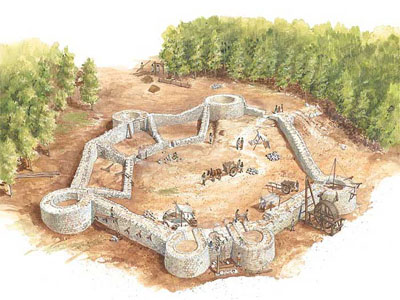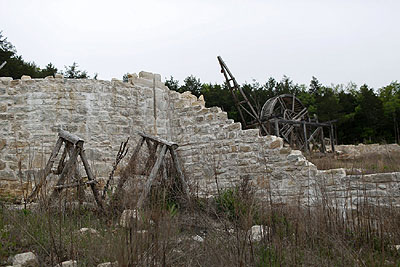



I received E-Mail that said:
There is a new castle underway--- built by the same group that is building the castle in France……it is a tourist attraction being built entirely by 13th century methods….
It is being built in Arkansas just south of Branson Mo.
Their castle in France is coming along nicely as well…..the roof is going up on the great hall and the towers are looking good too…….It has a whole “town” build around it, with shops building castle building materials like tile, pottery, lumber, furniture, shingles, etc….They show a map of your self guided tour but I don’t read French very well to know everything they have going on……
On 11-24-16, I received e-mail that said:
The Seattle Times newspaper of Sunday, June 2, 2013 ran a story from the New York Times, by Bret Schulte. It is as follows:
LEAD HILL, Ark. — It was supposed to be a fairy tale come to life, but the hard truth can be read on the signs along Highway 14. One trumpets, “A castle in the making” and “They’re building it. Come see it!” The other sign, more recent, is a lament: “Closed for the season.”
That was two seasons ago.
The Ozark Medieval Fortress, an attraction founded in 2010 but built with 13th-century methods for tourists, is now a ruin — at least financially. And its investors face a challenge perhaps even greater than building a castle by hand: trying to sell it.
The castle opened as an exotic idea imported from France. Tourists paid to step back in time, mingle with laborers in tunics and observe medieval tools and techniques. At stations surrounding the work site, they tried carving stone, making rope and forging iron. A human-scale hamster wheel powered a crane for heavy lifting. Artisans baked medieval bread, mead not provided.
“Lots of people know about the medieval but never see a castle,” said Jean-Marc Mirat, 73, one of the founders. “To build one here, I think the idea is pretty good.”
Situated on a mountainside, the castle was to rise 45 feet, complete with a drawbridge and a working farm, by the end of its 20-year construction schedule. But in January last year, besieged by market forces, the Ozark Medieval Fortress succumbed.
Today, the limestone walls stand unfinished, ranging from 2 to 15 feet high. A rope flutters from a slumping catapult. Rodents are using the toolbox in the stone-carving station as a throne, so to speak.
“We have many ideas, but no money,” Mirat said. “This is hard to do.” The investors, 15 French citizens including Mirat and his wife, Solange, sank $1.7 million into the project. Their asking price now: $400,000. Still, potential buyers are not storming the walls. In fact, no one knows how to even find any.
“If I seem baffled, I suppose I am,” said Mirat’s real-estate agent, Roger Turner of Re/Max. He listed the site on his company’s website and a few others but, “I don’t think the individual interested in this type of property is looking on remax.com,” he admitted.
The initial investment is not the main obstacle, Turner said. “You have to have a broad enough vision of what you would do with it,” he said.
The original vision came from Michel Guyot, the Frenchman behind just such a castle in the Burgundy region of France. That castle-in-the-making, Guédelon, has drawn tourists from around the world, including the Mirats, who make annual trips back to France from their home in Arkansas.
The couple retired here more than two decades ago to be near their daughter, Flavie, who lives outside Branson, Mo., with her American husband and children.
Seeing Guédelon in 2008 inspired Mirat to create a New World version of the castle on his land. Revenue would come from some of the 8 million annual visitors to Branson, which is 30 miles north of the Mirats’ 1,000 acres of nearly pristine Ozark mountainside and valley.
He enlisted Guyot, who helped create a limited liability corporation of French investors who contributed an initial $1.5 million — money that was nearly gone by the time the land was cleared and a parking lot and a welcome center were created. Nevertheless, after its debut in May 2010, the castle garnered national headlines and a visit by Larry the Cable Guy for his show “Only in America.”
Investors expected 150,000 paying tourists that first year. Just 12,000 showed up. In 2011, the castle slashed its payroll and increased the admission fee to $18 from $12 per adult.
Tourism dropped still lower, and visitors complained of insufficient personnel. The castle offered neither food nor beverages to weary travelers, and the nearest restaurant was 12 miles away. Meanwhile, the site manager returned to France for personal matters. She was not replaced.
Many investors never visited, and the languishing project closed before the 2012 season. Jean Revault d’Allonnes, an investor who still believes in the castle’s viability, said in an email that it “was underfunded from the beginning,” particularly its advertising budget.
While Guyot and many other investors have written off the project, Mirat, d’Allonnes and a few others hope to find a buyer who will invest in their vision. D’Allonnes has drafted business plans. One would require $1.3 million to finance a restaurant, an RV park, a hotel and medieval attractions like apothecaries and the on-site fabrication of leather, soap, fabric and more.
Turner has taken a handful of calls about the property; no one has the financing. He has spoken to developers in Branson: “They have a long-term game plan, and this isn’t it,” he said.
Still, he has taken some interested parties to the site. They see the half-built towers, the smithy with a bellows large enough to blow over a child, the kiln and shattered pottery. They see the eerie human hamster wheel. And they might see someone tilting at windmills.
Turner said some were “interested in the dream, but it’s a little overwhelming. They don’t know what to do.”
{{Castlefinder note!}}
This is sad news. I certainly hope someone sees the value in this project
and gets it going again.
Back to "Castles of the United States"